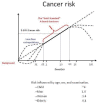The radiation issue in cardiology: the time for action is now
- PMID: 22104562
- PMCID: PMC3256101
- DOI: 10.1186/1476-7120-9-35
The radiation issue in cardiology: the time for action is now
Abstract
The "radiation issue" is the need to consider possible deterministic effects (e.g., skin injuries) and long-term cancer risks due to ionizing radiation in the risk-benefit assessment of diagnostic or therapeutic testing. Although there are currently no data showing that high-dose medical studies have actually increased the incidence of cancer, the "linear-no threshold" model in radioprotection assumes that no safe dose exists; all doses add up in determining cancer risks; and the risk increases linearly with increasing radiation dose. The possibility of deterministic effects should also be considered when skin or lens doses may be over the threshold. Cardiologists have a special mission to avoid unjustified or non-optimized use of radiation, since they are responsible for 45% of the entire cumulative effective dose of 3.0 mSv (similar to the radiological risk of 150 chest x-rays) per head per year to the US population from all medical sources except radiotherapy. In addition, interventional cardiologists have an exposure per head per year two to three times higher than that of radiologists. The most active and experienced interventional cardiologists in high volume cath labs have an annual exposure equivalent to around 5 mSv per head and a professional lifetime attributable to excess cancer risk on the order of magnitude of 1 in 100. Cardiologists are the contemporary radiologists but sometimes imperfectly aware of the radiological dose of the examination they prescribe or practice, which can range from the equivalent of 1-60 mSv around a reference dose average of 10-15 mSv for a percutaneous coronary intervention, a cardiac radiofrequency ablation, a multi-detector coronary angiography, or a myocardial perfusion imaging scintigraphy. A good cardiologist cannot be afraid of life-saving radiation, but must be afraid of radiation unawareness and negligence.
Figures






Similar articles
-
The appropriate and justified use of medical radiation in cardiovascular imaging: a position document of the ESC Associations of Cardiovascular Imaging, Percutaneous Cardiovascular Interventions and Electrophysiology.Eur Heart J. 2014 Mar;35(10):665-72. doi: 10.1093/eurheartj/eht394. Epub 2014 Jan 8. Eur Heart J. 2014. PMID: 24401558 Review.
-
[Over diagnostic imaging in cardiology].Recenti Prog Med. 2014 Mar;105(3):93-9. doi: 10.1701/1434.15868. Recenti Prog Med. 2014. PMID: 24675449 Italian.
-
Radioprotection (un)awareness in cardiologists, and how to improve it.Int J Cardiovasc Imaging. 2012 Aug;28(6):1369-74. doi: 10.1007/s10554-011-9937-8. Epub 2011 Aug 18. Int J Cardiovasc Imaging. 2012. PMID: 21850411
-
Reproductive effects of low-to-moderate medical radiation exposure.Curr Med Chem. 2012;19(36):6171-7. Curr Med Chem. 2012. PMID: 23033948
-
Risks Related To Fluoroscopy Radiation Associated With Electrophysiology Procedures.J Atr Fibrillation. 2014 Aug 31;7(2):1044. doi: 10.4022/jafib.1044. eCollection 2014 Aug-Sep. J Atr Fibrillation. 2014. PMID: 27957094 Free PMC article. Review.
Cited by
-
Coil Embolization for Cerebral Aneurysm Using Low Pulse Rate Fluoroscopy.Neurol Med Chir (Tokyo). 2024 Oct 15;64(10):353-359. doi: 10.2176/jns-nmc.2024-0069. Epub 2024 Aug 28. Neurol Med Chir (Tokyo). 2024. PMID: 39198154 Free PMC article.
-
Occupational radiation exposure in doctors: an analysis of exposure rates over 25 years.Br J Radiol. 2021 Nov 1;94(1127):20210602. doi: 10.1259/bjr.20210602. Epub 2021 Sep 19. Br J Radiol. 2021. PMID: 34538079 Free PMC article.
-
Remote-controlled cholangiography injection device: first clinical study in China.BMC Gastroenterol. 2022 Jan 7;22(1):12. doi: 10.1186/s12876-021-02087-8. BMC Gastroenterol. 2022. PMID: 34996384 Free PMC article.
-
A "Failed" Assay Development for the Discovery of Rescuing Small Molecules from the Radiation Damage.SLAS Discov. 2021 Dec;26(10):1315-1325. doi: 10.1177/24725552211020678. Epub 2021 Jun 19. SLAS Discov. 2021. PMID: 34151632 Free PMC article.
-
Effective Reduction of Radiation Exposure during Cardiac Catheterization.Tex Heart Inst J. 2019 Jun 1;46(3):167-171. doi: 10.14503/THIJ-17-6548. eCollection 2019 Jun. Tex Heart Inst J. 2019. PMID: 31708696 Free PMC article.
References
-
- Council Directive 97/43/Euratom of 30 June 1997 on health protection of individuals against the dangers of ionising radiation in relation to medical exposure, and repealing Directive 84/466/Euratom. Official Journal of the European Communities. 1997;L 180:0022–7.
-
- European Commission on Radiation Protection 118: Referral guidelines for imaging. http://ec.europa.eu/energy/nuclear/radioprotection/publication/doc/118_e... (last accessed September 21, 2011)
Publication types
MeSH terms
Substances
LinkOut - more resources
Full Text Sources
Medical

